Gaseous Mercury Detector UT3000
Gaseous Mercury Detector UT3000
Measurement of Total Gaseous Mercury in Air or Other Gases at Ultratrace Levels (ppq - parts per quadrillion)

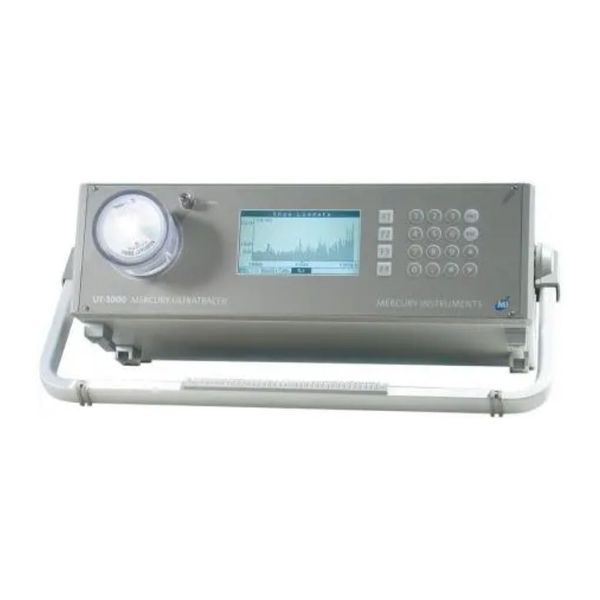
Additional Product Details
Atomic Absorption with Proprietary MI GoldTrap technology
Advanced AA photometer with stabilized Hg EDL lamp
Display of real-time signal reading
Display of results in bar graph
Data Logger
Exports data to PC
Optional Auto-Calibrate
Pollution prevention
Sturdy construction
Membrane key pad
Liquid crystal display

Mercury Monitoring Application
The UT-3000 Mercury UltraTracer provides a compact and reliable mercury analysis tool for measuring mercury in gases at ultra-trace levels. Utilizing the high-performance GoldTrap amalgamation module and an optimized state-of-the-art AA mercury vapor detector, the UT-3000 UltraTracer offers detection limits at sub-ng/m³ (ppq-parts per quadrillion) levels.
Applications include:
Air quality studies
Monitoring of indoor air pollution
Environmental pollution source tracking
Plume profiling
Studies of mercury dispersion in the atmosphere
Studies of interaction between atmosphere and surfaces
Pollution prevention
Natural gas and derivatives
Hydrogen and other gases
Soil and ground degassing studies
Hg Measuring Principle
The sample gas is fed into an optical cell by a maintenance-free membrane pump. A beam of UV light passes through the optical cell, and a part of it is absorbed by the mercury atoms present in the sample. This mercury detection method is called Atomic Absorption Spectroscopy; or shortly AAS. It is extremely selective and sensitive. For mercury determination, the AAS method has maintained its importance even if other methods have been worked out since the early beginnings. The AAS method is low in interference and does not require an amalgamation step or expensive carrier gases.
Mercury Monitoring in Natural Gas and LNG
Mercury is a frequent constituent of natural gas. It can be found in concentrations from a few µg/m³ up to 10000 µg/m³. An important application for the UT-3000 is the measurement of mercury in natural gas and liquefied natural gas (LNG). A special version of the UT-3000 analyzer is dedicated to the measurement of mercury in natural gas. Both a manual system using the Tedlar® Bag Technique as well as an automatic system for online installations are available.
Click here to Download more information about the natural gas application (8 pages)
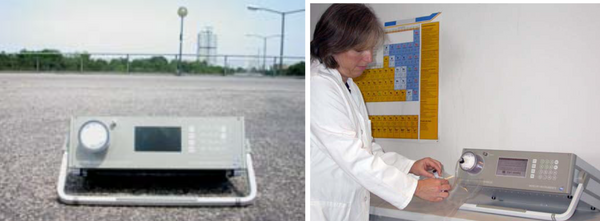
Automated Mercury Detector Operation
The UT-3000 operates automatically. All functions are controlled by an embedded microprocessor. Once the analysis has been started, measurements are performed and data is collected by the built-in data logger. With standard settings, the data logger has a recording capacity of four weeks.
Measurement of urban air quality measurement of air sample from Tedlar® Bag
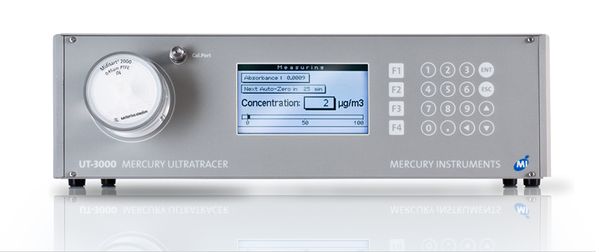
GoldTrap Amalgamation System
For use in the UT-3000, a new trapping system has been developed: the Mercury GoldTrap, which is one of the key components of the system. It consists of a wafer-thin ceramic tube that has been carefully crafted to achieve minimum thermal inertia. The tube has been packed with ultrapure gold and supports a heating coil on its outside. The Mercury GoldTrap reveals sharp and high peaks with excellent long-term stability. As air is used for purging the trap during the heating step, possible contaminations are oxidized and swept off, thus preventing passivation.
Atomic Absorption Detector
The mercury vapor detector used in the UT-3000 provides maximum sensitivity, precision, and stability. A high-frequency driven electrodeless mercury low-pressure lamp is used as a UV light source. It generates a 253.7 nm emission line of an extremely narrow bandwidth congruent with the absorption line of the Hg atoms measured. The reference beam method is applied to get an exceedingly high stability of the UV source. The mercury concentration is measured in an optical cell made entirely of fused silica (Suprasil). Thanks to the sensitivity enhancement provided by the GoldTrap, there is no need for a long-path cell, which always has a greater surface effect. Recent solid-state UV detectors with subsequent digital signal processing are used for absorption measurement.
Mercury Sampling
It is essential that the trap is free of mercury before sampling. This is ensured by a cleaning step, which is automatically performed. To keep particles out of the system and to protect the trap from passivation, a filter is installed upstream of the sample inlet. The filter is made of low-interactive material; the filter membrane has a porosity of 0.45 µm and is made of PTFE. The complete filter unit is easily replaceable.
Mercury in Natural Gas UT 3000 Video
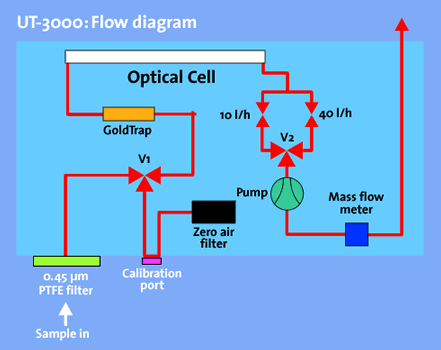
Mercury Sample Flow Control
The sample flow is measured with a high-precision electronic mass flow meter. The flow rate integrated over time gives the total sample volume. The flow is automatically changed to a lower value during the desorption step to achieve maximum sensitivity.
UT-3000: Flow diagram
How does the UT-3000 Mercury Analyzer work?
The Mercury Instruments GoldTrap is used to capture total gaseous mercury (TGM) directly from the atmosphere. GoldTraps work because mercury sticks to gold at room temperature. When a gas carrying gaseous mercury is pulled through the trap; the gas continues to flow through the trap but the mercury stays behind — trapped on the gold. After the mercury is captured, the GoldTrap is heated very quickly; this releases the mercury as a gas (thermal desorption). The gaseous mercury is then swept by the flow of purified, mercury-free air into the optical cell of the detector. Here the mercury is measured by atomic absorption spectrometry.
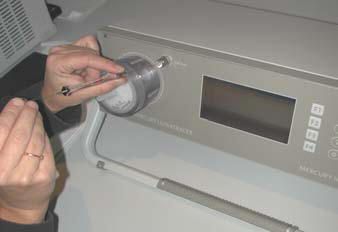
Calibration of Mercury Gas Detector
There are two methods to check and calibrate the instrument. One way is to capture mercury on the GoldTrap by bubbling air through a liquid mercury standard to which a stannous chloride solution has been added. Another quick, accurate, and precise way is the static calibration with mercury-saturated air. Gaseous mercury is injected directly on the GoldTrap. In this case, the built-in calibration port is used which is internally connected to the sample gas line leading into the GoldTrap. The calibration port is equipped with a septum through which gaseous mercury is injected with a syringe. The type of syringe used for this purpose is specially designed to measure and dispense gases. The mercury is then automatically drawn onto the GoldTrap. Calibration gas sources are available as accessories. The calibration check procedure can be automated as an option.
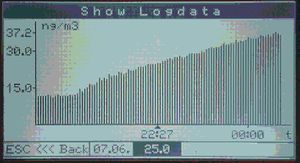
Display and Output of Mercury Measurements
The results of the measurements are displayed on a graphic LCD as a bar graph and numerically. It is possible to view past readings with a paging function. Calibrations are stored in a non-volatile memory. The device has a serial interface for data transfer to a PC and a 0-20 mA output.
Advantages of the AA Detection Method for Mercury
The latest AA detection technique used in the UT-3000 offers some clear advantages over other methods. Mercury trace detection by fluorescence must use a carrier and sometimes a sheath gas and suffers from the quenching effect which can never be completely eliminated. The UT-3000 requires no expensive gases for operation and there are no negative interferences caused by the quenching effect. Sensitivity and detection limits are far superior to those instruments based on the measurement of the electrical resistivity of a thin gold film.
Technical Specifications of the MMS
| Measuring principle | Collection of mercury onto a gold trap and subsequent release by fast heating, detection by AA |
|---|---|
| Mercury collector | Proprietary MI GoldTrap |
| Detector | Advanced AA photometer with stabilized electrodeless mercury discharge lamp, wavelength = 253,7 nm |
| Sample volume | 0.1 l to 100 l |
| Sampling volume | approx. 70 °C |
| Sampling duration | 10 seconds to 15 minutes |
| Measurement cycle time | 10 seconds to 16 min |
| Detection limit | 0.1 ng/m3 corresponding to 0.5 pg Hg absolutely |
| Measuring range | at 10 l sample volume: 0.1 ng/m3 to 2000 ng/m³at 1 l sample volume: 1 ng/m3 to 10000 ng/m³ |
| Sample volume determination: | Electronic massflow meter |
| Sample pump | Membrane pump, Viton |
| Sample inlet | 0.45 µm PTFE membrane filter, disposable |
| Calibration port | PTFE coated silicone rubber septum |
| Carrier gas | Not required |
| Data display | Display of real-time signal reading during gold trap heating period, display of measurement results in a barcode diagram |
| Data logger function | Built-in data logger for record of 10000 measurements (up to 100 days) |
| Data output | USB / RS232 to a computer (PC or Laptop) |
| Calibration | Through calibration gas injection port, manually using calibration gas source and syringe (optionally available), automatic with calibration source (option) |
| Power supply | 110 V or 230 V 50/60 Hz |
| Power consumption | Max. 125 W (heating peak) |
| Dimensions | 45 x 15 x 35 cm (W x H x D) |
| Weight | 45 x 15 x 35 cm (W x H x D) |
| Temperature range | 5°C to 35°C |
| Accessories | Calibration set for static calibrationAutomatic calibration deviceMC-3000 Dynamic Calibration Gas GeneratorCarrying case with handle and wheelsMains independent power supply pack |
| ISO 9001 | As a leading supplier of high precision analytical equipment, we strive at all times to offer top quality solutions. Our products are manufactured according to the ISO 9001 quality regulations. |
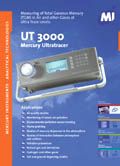
Downloads
Download our digital brochure to learn more about about product details, safety information and other special features and benefits.
Purchasing Information
Interested in purchasing or renting one of our products? Get started by requesting a quote. A member of our team will contact you directly with more information and next steps.
